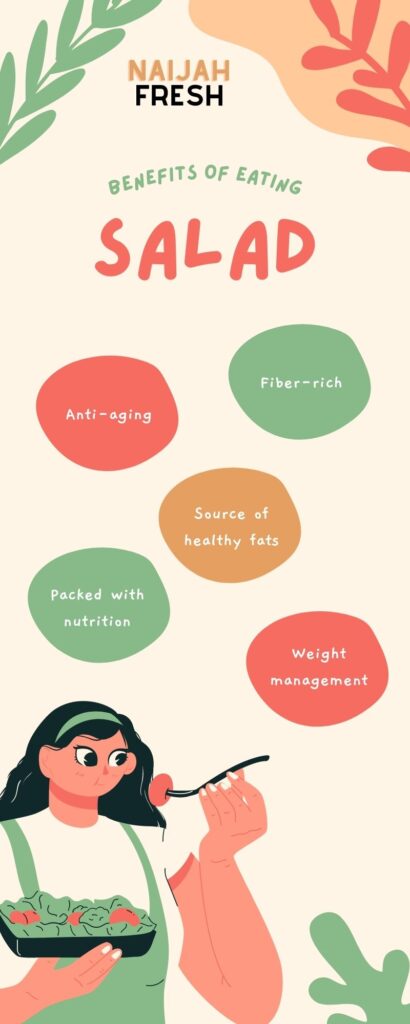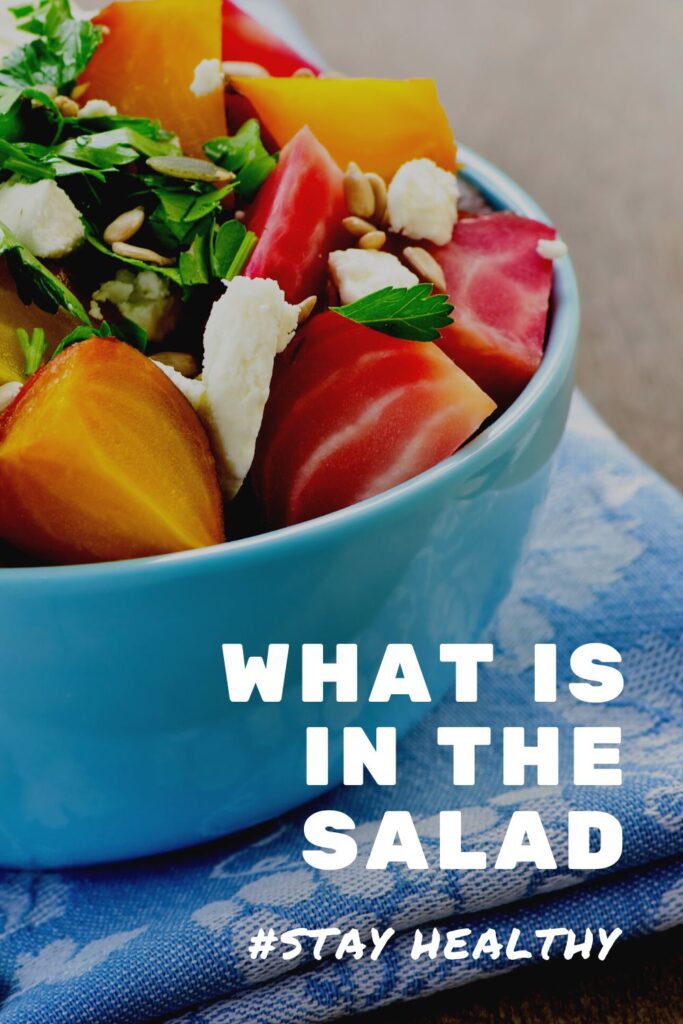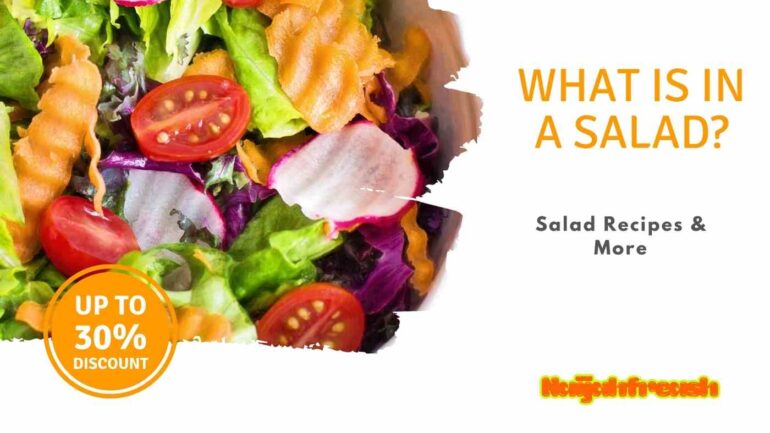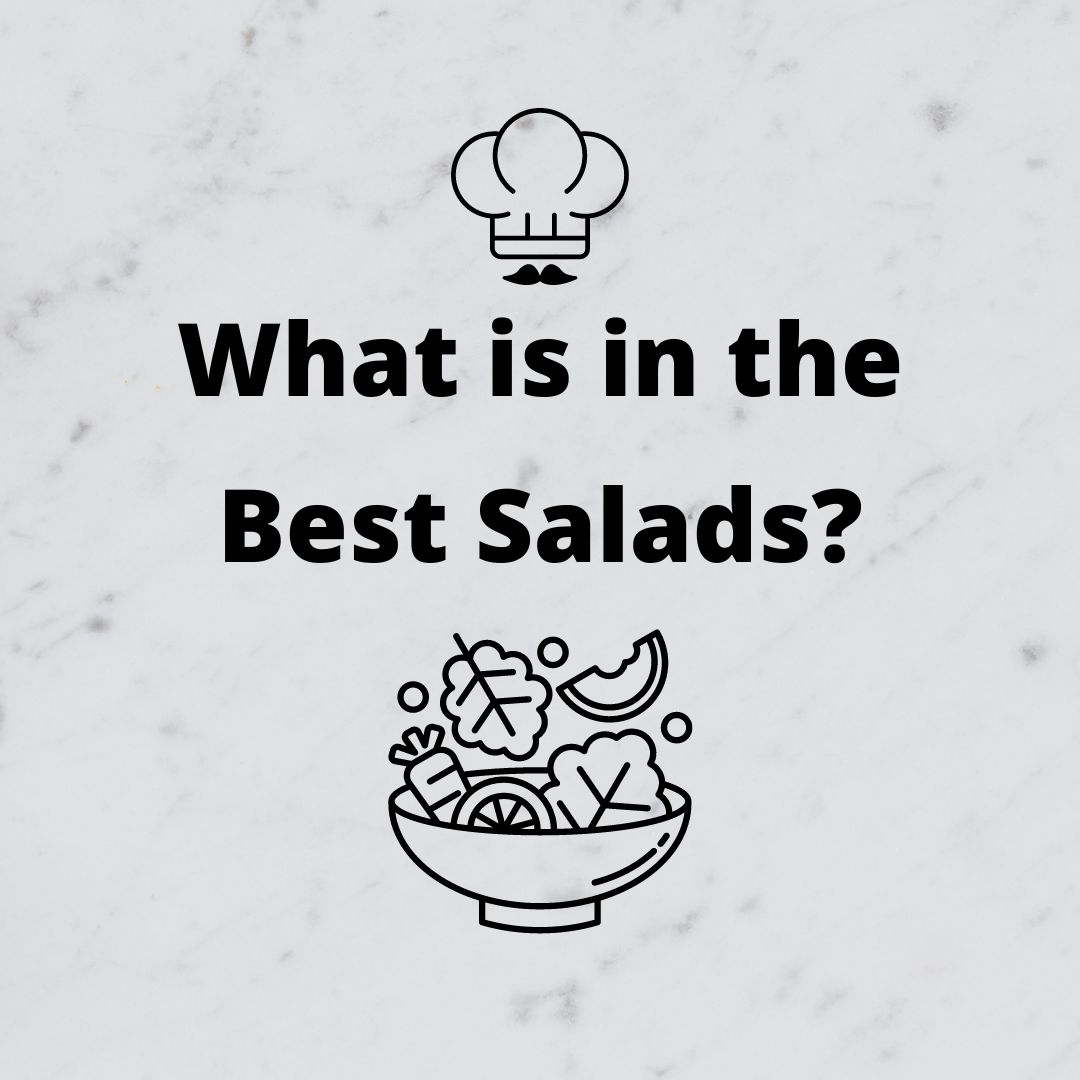Common salad ingredients
Common raw vegetables used in a salad include cucumbers, peppers, tomatoes, onions, carrots, celery, radishes, mushrooms, avocado, olives, artichoke hearts, the heart of palm, watercress, parsley, garden beets, and green beans. Nuts, berries, seeds, lentils, and flowers are less common components.
The four basic parts of most salads are:
The base of a salad is usually a layer of salad greens that line the plate or bowl in which the salad will be served.
The body of the salad consists of the main ingredients.
Garnish enhances the appearance of the salad while also complementing the overall taste.
Salad dressings are liquids or semi-liquids used to flavor salads.
What are the types of salad?
There are 5 basic types of salad.
- Green salads (tossed or composed)
Prepare all ingredients individually for either salad.
- Bound salads
Bound salad is prepared from cooked primary ingredients such as meat, poultry, fish, and egg, or starch such as potato, pasta, or rice.
- Vegetable salads
Prepare a vegetable salad from cooked and/or raw vegetables.
- Fruit salads
Fruit salad is prepared from fruit using a slightly sweet or sweet/sour dressing to enhance the flavor.
- Combination salads
A combination salad incorporates a combination of any of the four salad types listed above.
Ways salad can be eaten
Salads can be used in five ways during the service courses:
A starter salad. It is served as an appetizer to the main meal. It is smaller in portion and consists of light, fresh, crisp ingredients to stimulate the appetite.
Accompaniment salad. It can be served as an accompaniment or as a side salad, with the main course of the meal. It is light and flavorful, but not too rich.
Main course salads. They are large enough to serve as a full meal and may contain protein ingredients, such as meat, poultry, seafood, egg, beans, or cheese.
The intermezzo salad is intended to be a palate cleanser after a rich dinner and before dessert.
Dessert salads. They are usually sweet and often contain fruits, sweetened gelatin, nuts, cream, and whipped cream. Waldorf salad is a popular dessert salad. It is a mixed fruit salad with nuts and a mild dressing.
Benefits of eating Salad

Is salad good for you?
Yes, it is super good to be incorporated into your diet.
Leafy green vegetables are nutrient-rich because leaves contain the light-catching, energy-converting machinery of plants. Salad greens contain Vitamin A, Vitamin C, beta-carotene, calcium, folate, fiber, and phytonutrients.
Leafy vegetables are a good choice for a healthful diet because they do not contain cholesterol and are naturally low in calories and sodium. Many of the health benefits that leafy greens provide come from phytonutrients, unique compounds that provide protection for plants.
Healthy salads help you get enough fruits and vegetables.
Vegetable and fruit salads are full of fibre.
Healthy salads cut calorie consumption.
You will get access to good fats.
It provides enough water.
What is the most popular salad?

Master chefs of the International Society of Epicures in Paris voted Caesar Salad as the greatest recipe to originate from the Americas in 50 years.
Caesar salad is one of the most popular and well-known salads in the world. The ingredients and preparation are very simple. However, in order to get a correct balance of all the ingredients, the order of assembly must be followed.
Other common salads
A side salad is very common on menus. It is generally lettuce with carrot, cucumber, and tomato and a choice of dressing.
Chef’s salad is a main dish salad (it also is a combination salad). It can vary but is usually lettuce with ham, turkey, cheese, boiled eggs, tomatoes, and cucumber. A choice of dressing is usually offered.
Cobb salad is mixed greens (iceberg or romaine, endive, and watercress) with chicken, bacon, avocado, tomato, boiled egg, chives, and blue cheese. It is dressed with a red-wine vinaigrette. It was invented at the Brown Derby restaurant in Hollywood.
Coleslaw fans endlessly debate the ratio of creaminess-to-tanginess in their coleslaw. A basic coleslaw consists of chopped or shredded green cabbage, tossed with a dressing made from mayonnaise, vinegar, sugar, salt, and pepper. Some people add shredded red cabbage or carrots for a bit of color. The crispiness and slight tartness of coleslaw make it a great companion to heavier entrees, like ribs, burgers, and even Chinese food.
How to make a cucumber salad
It is a light and refreshing cucumber salad recipe. It is perfect for a warm summer day. It’s a great side for just about anything you put on the grill – chicken, steak, and fish.
This nutritious salad is not only wholesome but also full of flavor
Ingredients
- English cucumbers. I prefer to use long English cucumbers for this salad, but you could also use any type of cucumber.
- White wine vinegar: You can substitute it with champagne or sherry vinegar, or even with apple cider vinegar.
- Sweeter (honey, maple syrup, or sugar). You only need just a little bit of sweetener to balance out the acidity of the vinegar. You can use any type of sweetener, or you can skip it if you want.
Direction
- Mix cucumber and onions in a large bowl.
- Mix white wine vinegar, water, salt, pepper, and sweetener in a small jar. Pour over the cucumbers and onions, and toss to coat.
- Sprinkle some fresh chopped dill and toss the salad.
Cucumber salad dressing
If you are wondering what dressing goes with this brand, look no further. This simple dressing is light and delicious. It’s made with white wine vinegar, water, a tablespoon of sweetener, fresh chopped dill, salt, and black pepper.
Types of Salad dressing
Salad dressing takes your greens to the next level. From thick ranch dressings to light vinaigrettes, there are a plethora of different options to dress salads with, and it’s imperative to know which dressings complement which ingredients best.
Vinaigrette dressing in its simplest form is made of oil and vinegar. Vinaigrettes are lighter, thinner dressings often used on more delicate ingredients, such as greens and vegetables.
Emulsified vinaigrettes have gone through the emulsion process. An emulsion is a mixture of ingredients that permanently stays together, unlike a suspension that eventually separates.
Mayonnaise-based dressings are typically creamy dressings, such as Russian, thousand islands, and blue cheese.
Mayonnaise is the most stable and thickest emulsified dressing. It contains a higher ratio of oil to vinegar and a greater quantity of egg yolks than is required for the emulsified vinaigrette.
The keys to ensuring a quality salad are:
- The freshness of the ingredients
The key to preparing good-tasting, interesting, attractive salads is to start with clean, fresh ingredients
Always thoroughly wash greens because dirt can lodge between leaves. The best way to clean greens is to dip them in and out of cold water.
- Having all the ingredients blend together in harmony
- Make sure the salad is appealing to the eye
- Raw pineapple and raw papaya should never be added to a gelatin (Jello) salad or mold. Enzymes in the fruit prevent the gelatin from setting up (getting firm).
Why salad garnishing?
Proper garnish complements the main dish in color, flavor, and texture.
Garnish should enhance the flavor of a dish.
The preparation of garnishes is an essential part of the dish.
Some garnishes can be prepared in bulk when plating and finishing hot and cold items.
What garnishes to use depends not only on the food being served but also on how the food is laid out on the plate.
The purpose of plate presentation is to enhance the eye appeal of the food.
Consider the flavor, texture, and appearance of the item being garnished when garnishing desserts.
Numerous items can be used to garnish desserts properly:
- Fruit coulis in wide varieties
- Whipped cream, flavored and unflavored
- Frosted mint leaves
- Chocolate work in the form of string work or formed pieces
- Spun sugar work
- Sweet sauces
The overall impact of the garnish on the appearance of the dessert is driven by the way the garnish is presented
Frequently Asked Questions
Eating a salad after a meal can help digestion while eating one before a meal may help discourage overeating. No matter when you choose to eat your salad it will still come with health benefits. The most important thing is that you have vegetables regularly.
The bulkiness of the lettuce and raw veggies rapidly fills the stomach and acutely reduces appetite, and subsequent mealtime intake.
The fat from the olive oil slows stomach emptying, which keeps you feeling fuller longer.
The oleic acid in the olive oil triggers a rapid and robust release of the “feel-full” hormone, CCK.
The vinegar’s acetic acid slows digestion, reducing the glycemic response of mealtime carbs, and it kicks up your metabolism a bit.
The raw vegetables require lots of chewing which prolongs the time food engages with the mouth leading to greater oro-sensory satiety.
You should store your salad for no more than five days before eating it.
Many pre-cooked salads contain mayonnaise-based dressings or products which spoil after about five days even when stored in the refrigerator. Determine the ingredients in your salad and keep it no longer than the shelf life of your fastest-spoiling ingredient.
Pizza is the salad of finely sliced or chopped raw cabbage, usually moistened with a mayonnaise dressing.
Pizzas are actually fairly traditional salads, based on ingredients. Both Pizza and traditional lettuce-based salads can have a wide variety of toppings while people still colloquially acknowledge them as members of their respective groups.



